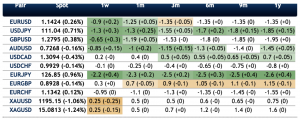A risk reversal is an options strategy designed to hedge directional strategies. For example, a long position will be hedged two-fold in a risk reversal scenario:
1) By buying a put option, or an instrument that on its own rises in value when the underlying security decreases in value (holding time constant), and
2) By selling a call option, which is also bearish. You generate a net return when the company fails to move above its strike price by expiration. You collect a premium by selling the option at the outset of the transaction.
This works by helping to cap downside risk with the put option, but the price of the option cuts into the profit potential of the trade given it adds cost. Selling an option generates a premium, but the more it rises, the more likely it is that the option lands in-the-money (ITM) and the profit loss from the exercising of the option (the party on the other side of the trade) exceeds the premium procured. It also can directly cancel out profit generated from being long the underlying.
Likewise, a short position can be hedged by:
1) Buying a call option, or an instrument that on its own rises in value when the underlying security increases in value (holding time constant), and
2) Selling a put option, which is also bullish.
You generate a net return when the company fails to move below its strike price by expiration. You collect a premium by selling the option.
Application
Risk reversals are commonly used to describe the implied trading biases among investors in currencies. It signals the difference in implied volatility between comparable call and put options.
The most important thing to understand about risk reversals is what the value of it – i.e., either positive or negative – signifies.
A positive risk reversal means that call options are more expensive than put options. This means that upside protection – for traders short the currency – is relatively expensive.
A negative risk reversal means that put options are more expensive than call options. This means that downside protection – for traders long the currency – is relatively expensive.
Below is a list of risk reversals for major pairs, and gold and silver relative to US dollars, courtesy of Saxo Group.

When there are material changes in the risk reversal this can indicate changing market expectations in the future direction of the underlying foreign exchange spot rate.
Therefore, risk reversals are typically used a signal of potential future trading activity. Accordingly, the use of risk reversals can be implemented as part of a broader strategy.
The Dynamics of the Risk Reversal
Positive risk reversal = Market is bullish on aggregate
Negative risk reversal = Market is bearish on aggregate
If call options are more expensive (i.e., positive risk reversal), that signifies that there is more market demand for them.
